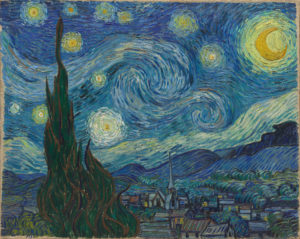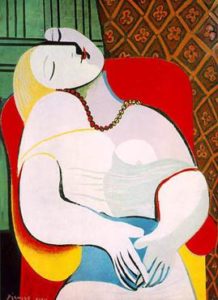Aesthetics
 For as long as I could remember I have been surrounded by art. This was primarily because of my particularly close relationship with my (step) grandfather Allen Wadsworth. Allen is a professional artist and in my opinion one of the best American artists today. You are probably familiar with some of his work without even knowing it as he painted the sets of Hollywood blockbusters such as Goonies, Hook, and even painted a living horse on location for a Clint Eastwood western. Though his work has made a profound impact on the lives of many throughout the years, it is his work done outside of the silver screen that always had my heart.
For as long as I could remember I have been surrounded by art. This was primarily because of my particularly close relationship with my (step) grandfather Allen Wadsworth. Allen is a professional artist and in my opinion one of the best American artists today. You are probably familiar with some of his work without even knowing it as he painted the sets of Hollywood blockbusters such as Goonies, Hook, and even painted a living horse on location for a Clint Eastwood western. Though his work has made a profound impact on the lives of many throughout the years, it is his work done outside of the silver screen that always had my heart.

The painting, 24’’ by 30’’ done in oil, is called “Bumble Bee – Ceremonial Dress”. I do not know why I became so attached to this particular painting as a little boy, but lately I have been trying to find out why I have. Why this one? What makes it so special? Who is that man? What is that expression on his face? To answer these questions and why I value this painting above another in the world, I find it helpful to look towards the school of philosophy called aesthetics for an answer.
The philosophical school of aesthetics is concerned with beauty, taste and the philosophy of art. Such questions thisschool seeks to answer the questions: What is art/beauty? What makes something beautiful? What is art? Can something be ugly and still be art? Why do we value it? The three major schools (and the ones I find most relevant for our discussion) are Essentialism, Functionalism, and Institutional Theories. Each school provides a different answer to each of these questions that will be explored in due course.
Essentialism
For an essentialist to consider something art there must be some feature in common among all art for it to be considered as such. For example, one could say it is a necessary condition for something to be considered art if and only if it is pleasing. That poses a problem, however, because not all art is pleasing, is it? We all know very well that some art does not sit with us as well as others, so the idea that the only qualification to art is that it must be pleasing is much too narrow of a definition. Looking let us examine two pieces of art that are seemingly very different to see if this theory works under proper context.


On the left, as I am sure you are well aware, is the impressionistic, “Starry Night” painted by Vincent Van Gogh in 1889. And on the right is one of the greatest known abstract paintings of all time, Kasimir Malevich’s 1916 work “Suprematist Composition”.
 Leading right off the previously posed question, we come to institutional theories. Those who adhere to this definition of art would believe what is art, and what is good art must be decided upon by an authority. I believe the perfect example of this theory to be the “Mona Lisa” by Leonardo Da Vinci painted from 1503 to 1506.
Leading right off the previously posed question, we come to institutional theories. Those who adhere to this definition of art would believe what is art, and what is good art must be decided upon by an authority. I believe the perfect example of this theory to be the “Mona Lisa” by Leonardo Da Vinci painted from 1503 to 1506. Pablo Picasso is widely considered one of the greatest artists of all time, and I believe a testament to his artistic genius was his ever-evolving style. To the left is his 1901 self-portrait painted during the height of his artistic phase known as the “Blue Period”. The “Blue Period” was a point of depression in Picasso’s life after the suicide of his best friend, Carlos Casagemas, where every single painting was done in a blue hue. The man’s picture differs dramatically from that of his previous self-portraits of a young, handsome man. This Picasso looks cold, clear by his bulky overcoat and looks unkempt, clear by his beard, long hair and sunken cheeks. But most striking of all, however, is the smile. He attempts a half-smile though it seems to hurt while the blue mist enshrouds him and transforms the lively handsome Picasso into a sickly unrecognizable character.
Pablo Picasso is widely considered one of the greatest artists of all time, and I believe a testament to his artistic genius was his ever-evolving style. To the left is his 1901 self-portrait painted during the height of his artistic phase known as the “Blue Period”. The “Blue Period” was a point of depression in Picasso’s life after the suicide of his best friend, Carlos Casagemas, where every single painting was done in a blue hue. The man’s picture differs dramatically from that of his previous self-portraits of a young, handsome man. This Picasso looks cold, clear by his bulky overcoat and looks unkempt, clear by his beard, long hair and sunken cheeks. But most striking of all, however, is the smile. He attempts a half-smile though it seems to hurt while the blue mist enshrouds him and transforms the lively handsome Picasso into a sickly unrecognizable character.  To the right is my personal favorite work by Picasso, “Le Reve” (translated to mean “the dream”) painted in 1932. The subject was Picasso’s 22-year-old lover Marie-Therese Walter. Marie was by no means an outstandingly beautiful girl, but yet this is by far Picasso’s most flattering depiction of a woman. Try if you would to put yourself in Picasso’s shoes as he’s watching his lover fall softly into sleep. You admire her round shoulders (as he seemed to exaggerate the most profound and unique aspect of his subjects’ figures) and moonlit skin that seems almost soft to the touch. Although her nose splits her face in two (Marie really had a very prominent nose) it is not exaggerated to the point of ugliness but forms her lovely full face into a heart. All while a sweet smile dances on her lips during a pleasant dream. “Could she be dreaming of me?” Picasso must have wondered.
To the right is my personal favorite work by Picasso, “Le Reve” (translated to mean “the dream”) painted in 1932. The subject was Picasso’s 22-year-old lover Marie-Therese Walter. Marie was by no means an outstandingly beautiful girl, but yet this is by far Picasso’s most flattering depiction of a woman. Try if you would to put yourself in Picasso’s shoes as he’s watching his lover fall softly into sleep. You admire her round shoulders (as he seemed to exaggerate the most profound and unique aspect of his subjects’ figures) and moonlit skin that seems almost soft to the touch. Although her nose splits her face in two (Marie really had a very prominent nose) it is not exaggerated to the point of ugliness but forms her lovely full face into a heart. All while a sweet smile dances on her lips during a pleasant dream. “Could she be dreaming of me?” Picasso must have wondered. So through meditation and adoption of a functionalist theory of aesthetics after all these years, I have finally found what makes me love that painting so much. Back in the seventies or eighties, my grandfather got special permission to take photographs of Native American rituals on reserves in northern California. These people lived and dressed similarly to you and me but once in a while on a very special occasion that would put on the clothes of their ancestors, dance, praise, love, and forget about the world around them. Forget about a world in which the white man treated them like dirt and forced them to live in a place where they did not want to live. Forget about a world unacceptant of them only because of the color of their skin. And forget about a world in which their ancestors were slaughtered by the millions, though they had committed no crime.
So through meditation and adoption of a functionalist theory of aesthetics after all these years, I have finally found what makes me love that painting so much. Back in the seventies or eighties, my grandfather got special permission to take photographs of Native American rituals on reserves in northern California. These people lived and dressed similarly to you and me but once in a while on a very special occasion that would put on the clothes of their ancestors, dance, praise, love, and forget about the world around them. Forget about a world in which the white man treated them like dirt and forced them to live in a place where they did not want to live. Forget about a world unacceptant of them only because of the color of their skin. And forget about a world in which their ancestors were slaughtered by the millions, though they had committed no crime.The Sound Mind Blog Series is intended for SigEp brothers to explore their own academic or intellectual interests while developing the minds of others. SigEp subscribes to the ancient Greek belief that the mind is central to humanity and thus the exercise of the mind is necessary for a balanced life. Developing a sound mind means living a lifestyle that allows you to expand your mind inside and outside of the classroom setting.
 Meet the Author
Meet the Author
William Heaton ’22
History & Philosophy Major
Balanced Man Scholarship Director







